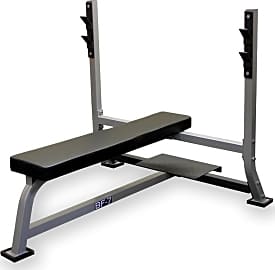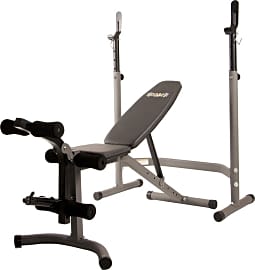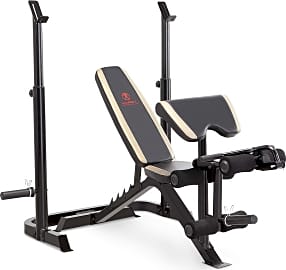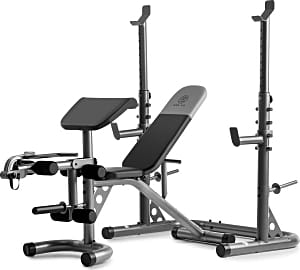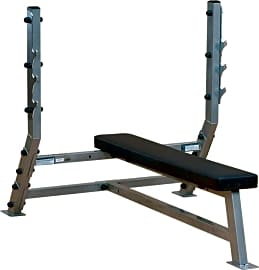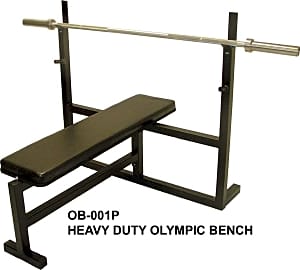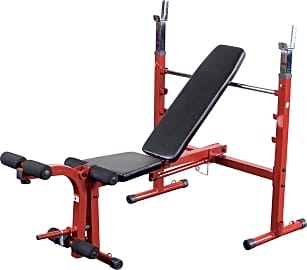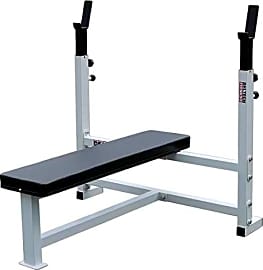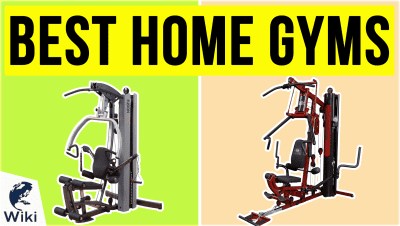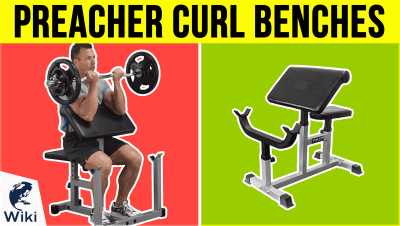The 10 Best Olympic Weight Benches

This wiki has been updated 47 times since it was first published in May of 2015. Specifically designed to hold a standard seven-foot lifting bar, Olympic weight benches are an essential piece of equipment when it comes to serious strength-training programs. Instead of joining an expensive commercial gym - and dealing with the commitment and commute - consider purchasing one of the options listed below and working out in the comfort of your own home. When users buy our independently chosen editorial picks, we may earn commissions to help fund the Wiki.
Editor's Notes
May 18, 2021:
Most of our choices from last year still made sense for this list, but we decided on phasing out the Phoenix 99226 Power Pro, which wasn’t available at the time of this writing and, with its integrated cable system and leg developer, might have actually been a better fit for our list of home gyms.
In its place, we added the Gold’s Gym XRS 20, which doubles as a preacher-curl bench and has built-in safety spotters for people who like to lift solo. It’s a great-looking and well-reviewed option, but there was some hesitancy on our part to rank it, as several users noted that the option they received wasn’t in fact a bona fide Gold’s Gym bench, but rather a duplicate design from Weider.
While our research wasn’t able to confirm that the two brands belong to the same parent company, the connection between Joe Weider and Gold’s Gym is well documented, and with more than one offering sharing similar designs, it seems likely that this is the case. So, considering that, the fact that both brands enjoy relatively good reputations and the fact most complaints regarding the issue surrounded the bench’s lack of visible branding, and not its actual build quality, we still felt comfortable recommending this option as an affordable, mid-level choice for users looking for a bench that can offer a little versatility.
For more fitness equipment to help build out your home or commercial gym, check out our lists of weight racks, rubber dumbbells and squat racks.
January 28, 2020:
For this update, we removed the XMarc Fitness XM-4424 and Deltech Fitness DF1000, due to availability concerns, and the fact that we already had similar options listed. Despite adding several new additions, we kept the Marcy Diamond MD-857 as our top choice. It's combination of low price, quality construction, and abundance of features just couldn't be beaten.
Since people in the market for Olympic-style weight benches are likely planning on lifting a significant amount of weight, we really wanted to make sure we had enough options with higher load capacity. Our previous list only had one entry that could handle more than 600 pounds - the Ader Black - so we added the Deltech Fitness, which can handle up to 750 pounds, and the Body-Solid SFB349G, a beast of a bench that maxes out at a hefty 1000 pounds. These don't have the bells and whistles that other models do, but if you're just looking to do some flat bench pressing, they'll do just fine.
Even though some of the entries on this list are designed to be used for squatting, they really aren't ideal if that's one of the primary lifts in your routine. A dedicated squat rack would be better suited for that. These have the strength and stability to handle exceptionally heavy bars crashing down on them.
No matter what type of equipment you get, any home gym can benefit from the installation of gym flooring. This specialized padding not only protects your floors, but it also keeps weight plates or bars from being damaged when they are inevitably dropped or knocked over.
Special Honors
Bells of Steel Finding room in your home for an olympic weight bench can be one important step toward better fitness, but it won't do you any good if you don't stock up on the correct companion equipment. This company offers a wide variety of bars and weight plates that will help you get the most out of your new purchase. bellsofsteel.com
Bowflex Once you've got your form dialed in, free weights are great. They're simple, and they help you hit your stabilizers at the same time as your main muscle groups, but they can also be daunting to tackle without a partner, and not all homes have enough space to comfortably house a selection of benches and bars. Bowflex offers two compact home gyms that enable users to do 70 and 100 exercises, respectively, and both are great choices for working out solo. bowflex.com
Why Go With an Olympic Weight Bench (As Opposed to a Standard One?)
Amateur weightlifters may not be able to spot a lot of divergence between an Olympic weight bench and an average one.
Amateur weightlifters may not be able to spot a lot of divergence between an Olympic weight bench and an average one. But the differences are substantial, and they could have a lasting impact on everything from a person's ability to avoid injuries to his or her ability to develop muscle.
Olympic weight benches are longer (approximately five feet) and wider (11 inches) than their standard counterparts. This may seem minor until you consider that a weight bench's support is essential to avoiding routine injuries. On average, Olympic benches are also heavier and more stabilized than their traditional counterparts, which means that they won't buckle under overwhelming stress.
Most Olympic benches come with a seven foot, 45 pound barbell. This is helpful for establishing a baseline weight before adding any individual plates. What's more, there are certain Olympic benches that come with their own set of free weights, or several matching plates (i.e., 2.5-45 lbs) that add up to a total of 300 lbs.
In the long term, an Olympic weight bench represents a much wiser investment than any standard model. Olympic benches are so reliable that, between barbell weight and body weight, they can accommodate up to 600 pounds, and a lot of these benches provide so many features that they can address a full range of strength-training workouts.
Several Basic Exercises That You Can Do on a Weight Bench
The most common exercise associated with a weight bench is the bench press. In accordance with its name, a bench press requires that you lie with your back resting flat against the upper half of the bench. Your feet should be placed firmly on the ground, positioned parallel with your shoulders. Raise your arms to lift the barbell, which should be placed along the overhead rack.
Now raise both legs until your feet are approximately six inches higher than your waist.
Pick up the bar with both hands, and then lower it until it rests within an inch of your chest. Hold, and then push the barbell back up until your arms have straightened out. Now repeat, bearing in mind that you can work the deltoids and the triceps by doing the same exercise while placing the bench at an incline.
Assuming you prefer to start in a standing position, move around to the back of the bench. Placing your hands parallel to your shoulders, grab the barbell and pull it up until it rests beneath your chin. Hold, and then lower the barbell until it reaches your stomach. Lift the barbell again, and repeat. This exercise, known as the barbell hang pull, is great for building your deltoids, your rhomboids, and your glutes. You can increase the difficulty by moving your hands closer together, or by increasing the weight on the bar.
On days when you want a break from the barbells, you can do some abdominal lifts to tone your core muscles. Lying flat on your back, take hold of the sides of the bench with both hands. Now raise both legs until your feet are approximately six inches higher than your waist. Hold this position for 20 seconds, and then lower your legs. Rest, and repeat. Over time, you can attempt to hold longer with each lift.
The goal with each of these exercises is to work up to doing 3-4 sets during a workout. To avoid muscle strains, it's best to focus on doing different exercises (thereby developing different muscle groups) on different days, and to avoid doing too many repetitions in one sitting.
A Brief History of The Weight Bench
The earliest form of repetition-based strength training was a push-up. Unlike lifting rocks or other massive objects, the push-up was an exercise that anyone could do. This might explain why the push-up dates all the way back to the Ancient Greeks and the Ancient Romans, and it also might explain why the push-up has remained so popular to this day.
This proved to be difficult in that the ground had zero give.
The only problem with a push-up, at least from a bodybuilding perspective, was that people would need to place static weights around their shoulders if they intended on building any additional muscle after arriving at a certain point. This proved to be difficult in that the ground had zero give. The Ancient Romans were the first to come up with the idea of pushing static weights forward, while gaining additional support by lying flat on their backs.
It wasn't until centuries later that the use of weighted bars came into play. These bars were important because they equally distributed the weight, thereby creating an opposing force that stimulated a person's muscles (a dynamic which would later become known as contraction).
Early barbells were designed with fixed orbs on either side. Iron plates were introduced during the 1800s, allowing for the easy addition or removal of weight from a standard bar. The first floor press (i.e., a chest press attempted while lying on a mat) was completed by a Russian bodybuilder named George Hackenschmidt in 1899. Floor presses remained a standard technique until the 1930s, at which point bodybuilders transitioned to pressing weights while lying on elevated boxes. These early "boxes" provided increased flexibility, while also eliminating a variety of safety concerns associated with pushing weight up from the floor.
The term bench press was popularized during the 1940s. Soon after, people began referring to weight boxes as benches, and the modern weight bench as we know it was born. Today, weight benches represent the central fixture of a multi-billion-dollar industry. You can find weight benches in every gym, and they are the most popular piece of fitness equipment that is sold for use within the home.


